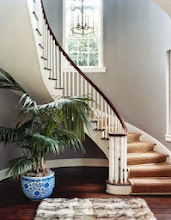
Many writers, particularly Canadian ones, have been inspired by the paintings of Emily Carr and the Group of Seven. I have seen her paintings many times at the Royal Ontario Museum and the Art Gallery of Ontario. A Tom Thomson hung on the wall of my childhood home. I can't attempt to explain what these paintings mean to me in any other way than how I have explained it below, in my poem Frontier. Someday I will expand this poem or use pieces of it for another, more complex poem on this subject.
In the meantime, though, I can tell you a little about the lines: "On her shades of grey, from dappled plum to ocean/ I hang silver tears; their transverse waves/ augment and diminish." My "tears" are a not just a literal response to being moved by her work, but they are meant as the filters of perceptions through which we all respond to visual stimuli. We each perceive and "see" things, especially art, differently from one another. In this metaphorical way, my "tears" also connote the fantastical idea that I have touched or changed the work somehow by seeing it, so that the painting will carry with it something of each of its viewers throughout its life.
The above painting and the one to the right are by Emily Carr. I hope you will leave your tears on my poem and return again to see what's changed.
Frontier
Materials that men have made
obscure what nature means to emphasize.
They decorate walls in synthetic shapes
nature did not make --------- their jades
will never match the gem -------------
To God, green
is the very substance
of the leaf itself.
To God, blue is chameleon
changing against desert sands --------------
mutation its very essence.
Most of what men make is grey:

endless slabs, great as lakes
sweeping continents, constituting castles. . .
warehouses. . . vast stadiums. . .
Inside earth, legacies
of craft and construct, of form and fashion
spur with wind their veiny waifs
to adjust the pressure, inciting newborn vines
to somnolently streak our stone-hewn homes
for inevitable weddings of spirit to mere substance.
Emily's paintings do not perform a function,
or try to fool me into thinking they are anything besides wild.
On her shades of grey, from dappled plum to ocean
I hang silver tears; their transverse waves
augment and diminish.

I envy you for this, Nicole; your ability to convey your response to art with such precision; and delighted to make the acquaintance, even in tiny reproductions, of this clearly important Canadian painter, who for her part is able to convey her response to Nature with such precision - her response and not just the shapes and colours captured by her retinas - and most important, able to convey her response to an audience to stimulate their response.
ReplyDeleteThank you.
I'm so glad you liked meeting Emily Carr!! Hopefully you will someday see her paintings in real life - they are much much larger! The first time I saw Monet's Waterlillies at The Met I sunk down into a bench and began to cry. The gallery attendant approached to ask if I was alright. "I just never knew it was so. . . . BIG," I blubbered.
ReplyDeleteIt's always important for me to try and explore the idea that the messages our senses gives our brains is never untouched by philosophy. For example, people who like the colour red don't place decorative red accents in abundance throughout their houses simply because they are red. They put them there because they LIKE them AND they are red. When we don't philosophize our stimuli it's due to a somewhat paradoxical act of deep relaxation.